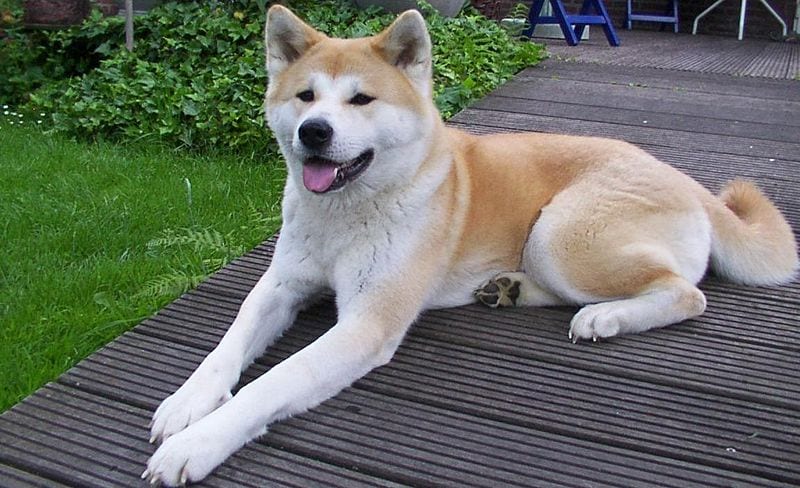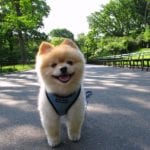
The Akita inu is one of those dog breeds that just by seeing it makes you fall in love. It has a very sweet look, and a coat so dense that you want to caress it over and over again. However, it is a very special animal that can be happy only if the family is willing to dedicate all the time it needs. Will it be yours?
I encourage you to find out in this special that we dedicate to what is one of the oldest races in the world.
Origin and history

Image - Wikimedia / B @ rt
The Akita inu is a breed with more than 3000 years of history. Originally from Japan, it was used as a bear hunting dog (called Matagi-inu), war dog (Kurae-inu), and providence dog (Odate-inu). But from 1603 humans wanted to use it as a fighting dog, so they crossed it with the Tosa Inu or the English Mastiff, which endangered the pure Akita inu.
Fortunately, in 1908 dog fighting was banned and the breed was able to recover, especially from 1927 when the commander of Odate created an »Akita inu Preservation Society».
Today it is considered the national dog of the Japanese countryIt was even designated a National Monument in 1931. Sadly, again in World War II it had to go through a very bad time: the skin was used to make clothes for the military, and the meat became food. Those who loved the Akitas, were able to take specimens to villages and small towns, where they pretended to have them as guard dogs. Some of them crossed with the German Shepherd.
After the war, several females were sold to the Americans, which gave rise to a new breed: the American Akita, which had traits more typical of the German shepherd and the mastiff. However, with those who stayed in Japan, they have been able to eliminate these foreign traits, returning the Akita inu breed to its natural beauty.
Physical characteristics
It is a large and strong animal. The male weighs 34 to 53kg and the female 30 to 49kg, and they are 64 to 71cm tall, the female being shorter than the male. Its body is robust, covered by a double coat of hair, the inner soft, and the outer rough and short of red, sesame, brindle or pure white.
The size of its head is proportional to the body. Their ears are rather small, triangular and stand erect and slightly inclined forward. The nose is usually black, as are the eyes. Its legs are webbed, which allows it to swim without difficulty.
Has a life expectancy of 10 years.
Behavior and personality
Despite what it may seem, it is a calm, reserved, and patient dog, that you will feel especially attached to your caregivers. Also, as long as he is treated with respect and affection, that is what he shows to others. Of course, it must be borne in mind that it has a very strong protective instinct towards the family and towards its things, but it will not cause problems if it is trained from a puppy.
You also have to know that it does not bark if it is not a good reason, so if our furry does it we will have to pay attention to it.
Care
Food
What to feed an Akita inu? As we are talking about a dog that is important to take out to exercise every day so that it is calm and, especially, so that it is happy, It is highly recommended to give dry feed with a high content of animal protein.
The frequency will depend a bit on your dog. You must bear in mind that there are dogs that need to eat three times a day, there are others that two, and there are even some that only eat once. If you see that your furry is content to eat twice a day, and you don't see him looking for food the rest of the time, then you probably don't need to give him more.
Of course, if on the contrary you see that he is left hungry, do not hesitate to give him more food. But also check his weight, since if he took on extra kilos it would not be good for him either since they could cause health problems such as diabetes or hypertension.
Hygiene
The fur of this animal is one of the parts of the body that will get the most dirty, and therefore, more will have to be cleaned. Once a month give him a good bath using warm water and a dog shampoo. If he is very afraid of water, you can keep him clean with a dry shampoo, since you will not need to bathe him.
Likewise, it is important to brush him daily. For this there is a highly recommended brush called Furminator. This is so effective that it is capable of removing around 90% of dead hair.
If we talk about their eyes and ears, you have to check them from time to time, and clean them with special products that your veterinarian can sell you.
Exercise
It is a calm dog, but we are not going to deceive you: like any good dog worth its salt, if it does not go out to exercise it will show its more… rebellious side. So that, Take it out for a walk every day, and if you are an athlete, take advantage of it and take it with you for a run.
"Salud"
The Akita inu is a dog that enjoys good health, but as it ages you may suffer from gastric torsion, or hip dysplasia. However, this is something that can be detected quickly if the dog is taken to the veterinary clinic or hospital for a professional review every year.
Obviously, if you do not want him to have young, it is highly advisable to have him castrate.
What is the difference between the Shiba Inu and the Akita Inu?
Both breeds look a lot alike, but undoubtedly the main difference is its size: while the Shiba Inu weighs between 8 and 15kg, and measures between 35 and 40 centimeters from the tip of the nose to the tail, our protagonist weighs between 35 and 55kg and measures between 60 and 70 centimeters.
Another important detail when choosing one breed or another is, how could it be otherwise, the character. The Shiba Inu, although they are difficult to change, adapt better than the Akita Inu to them.
Last but not least, the life expectancy of one and the other changes. The Shiba Inu can live between 12 and 15 years, but the Akita Inu between 10 and 12 years.
How much does an Akita inu cost?
If you have decided to buy a puppy, you should keep in mind that more or less the price is about $1000.
Hachiko, the most loyal Akita inu

Stuffed remains of Hachiko exhibited at the Tokyo Museum of Nature and Science.
Image - Wikimedia / Momotarou2012
Do you know the story of Hachiko? This beautiful animal, which was born in Odate on November 10, 1923 and died in Tokyo on March 8, 1935, will be remembered for the loyalty he showed to his caretaker Hidesaburo Ueno, who was a professor in the Department of Agriculture at the University of Tokyo.
Since Ueno found it, Hachiko accompanied him every day to Shibuya station, and stayed there, waiting for him until his workday was over. But on May 21, 1925, the professor did not return. He had suffered cardiac arrest while teaching, and passed away.
The dog He did not move from the train station for the next 9 years of his life, during which he was fed and cared for by people who had witnessed the affection he felt for his human.
A year before his death, in April 1934, a statue was erected at the station in honor of Hachiko, who was present. Today, every March 8 he is commemorated at that station.
Photos
Finally, we attach a series of beautiful photos for you to enjoy:


